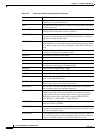
15-10
Cisco ONS 15454 Reference Manual, R7.0
78-17191-01
Chapter 15 Performance Monitoring
15.4 15.4 Performance Monitoring Parameter Definitions
PSD-S In a four-fiber BLSR, Protection Switching Duration-Span (PSD-S) is a
count of the seconds that the protection line was used to carry service. A
count is only incremented if span switching is used.
SASCP-P SEF/AIS Seconds CP-bit Path (SASCP-P) is a count of one-second
intervals containing one or more SEFs or one or more AIS defects on the
path.
SASP SEF/AIS Seconds (SASP) is a count of one-second intervals containing
one or more SEFs or one or more AIS defects on the path.
SASP-P SEF/AIS Seconds Path (SASP-P) is a count of one-second intervals
containing one or more SEFs or one or more AIS defects on the path.
SEF-S Severely Errored Framing Seconds (SEFS-S) is a count of the seconds
when an SEF defect was present. An SEF defect is expected to be present
during most seconds when an LOS or loss of frame (LOF) defect is
present. However, there can be situations when the SEFS-S parameter is
only incremented based on the presence of the SEF defect.
SESCP-P Severely Errored Seconds CP-bit Path (SESCP-P) is a count of seconds
containing more than 44 CP-bit parity errors, one or more SEF defects, or
one or more AIS defects.
SESCP-PFE Severely Errored Seconds CP-bit Path (SESCP-PFE) is a count of
one-second intervals containing one or more far-end SEF/AIS defects, or
one or more 44 M-frames with the three FEBE bits not all collectively set
to 1.
SES-L Line Severely Errored Seconds (SES-L) is a count of the seconds
containing more than a particular quantity of anomalies (BPV + EXZ >
44) and/or defects on the line.
SES-P Near-End STS Path Severely Errored Seconds (SES-P) is a count of the
seconds when K (2400) or more STS path BIP errors were detected. An
AIS-P defect (or a lower-layer, traffic-related, near-end defect) or an
LOP-P defect can also cause an SES-P.
SES-PFE Far-End STS Path Severely Errored Seconds (SES-PFE) is a count of the
seconds when K (2400) or more STS path BIP errors were detected. An
AIS-P defect (or a lower-layer, traffic-related, far-end defect) or an LOP-P
defect can also cause an SES-PFE.
SES-PM Path Monitoring Severely Errored Seconds (SES-PM) indicates the
severely errored seconds recorded in the OTN path during the PM time
interval.
SESP-P Severely Errored Seconds Path (SESP-P) is a count of seconds containing
more than 44 P-bit parity violations, one or more SEF defects, or one or
more AIS defects.
SES-S Section Severely Errored Seconds (SES-S) is a count of the seconds when
K (see Telcordia GR-253 for value) or more section-layer BIP errors were
detected or an SEF or LOS defect was present.
SES-SM Section Monitoring Severely Errored Seconds (SES-SM) indicates the
severely errored seconds recorded in the OTN section during the PM time
interval.
Table 15-3 Performance Monitoring Parameters (continued)
Parameter Definition


















